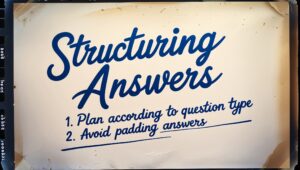Mastering Exam Writing: Techniques, Tips, and Strategies for Success
When it comes to preparing for exams, exam writing is a skill many students underestimate. Yet, strong exam writing skills can significantly impact your grades, helping you present your knowledge clearly and effectively. Whether you’re tackling essay-based exams, multiple-choice formats, or short written answers, understanding the nuances of each exam type can make all the difference.
This guide breaks down essential exam writing techniques, tailored strategies, and preparation tips for various types of exams. By the time you finish reading, you’ll have actionable advice to help you write better under pressure and achieve your academic goals.
Understanding Exam Writing
Different Types of Exams
Exams come in many formats, and each requires a unique approach to writing. Here’s a quick breakdown of common exam styles and their requirements:
- Essay-Based Exams: Common in arts exams like History and English. They require detailed responses supported by evidence.
- Multiple-Choice Questions (choice questions): Typically found in science or standardized exams such as the IELTS Academic Reading test.
- Short Written Answers: Found in subjects like biology or engineering, these exams demand concise and clear responses.
- Closed Book Exams (doubt exams, actual clock time exams): Rely on memory and preparation without reference materials.
By understanding the types of exams you’ll face, you can tailor your preparation and improve your performance.
Importance of Strong Exam Writing Skills
Why Exam Writing Matters
Effective exam writing plays a vital role in academic success. Here’s why it should be a priority for every student, from school students to university-level learners:
- Clear Communication: Exams test your ability to explain complex ideas simply. Skills like using a citation style and organizing your thoughts are critical.
- Maximized Marks: Structuring your writing and including relevant claims with evidence ensures you earn as many marks as possible.
- Proofreading for Success: A final review of your answers can address errors in grammar, correct vocabulary items, or illegible handwriting that may cost points.
Real-Life Scenarios
Imagine sitting an engineering exam and losing precious marks because your short answer lacked clarity, or missing out on points in an arts exam because your essay lacked structure. Solid writing skills ensure these scenarios don’t happen.
Techniques for Exam Writing Success
Step 1: Time Planning
Good writing starts with effective time management. Follow these tips:
- Allocate planning time for each question. For example, spend 5 minutes planning longer essays.
- Use an actual clock time strategy to divide the exam duration among sections based on their weightage.
Step 2: Structuring Your Answers
How you structure your response depends on the question type.
Essay Exams
- Read the Question Carefully: Decode the exam essay prompt to understand its central theme.
- Plan Before You Write: Create an essay plan, outlining your body paragraphs (e.g., introduction, three supporting paragraphs, and a conclusion).
- Stay On Topic: Address the question directly using concrete evidence to back up your arguments.
Short Written Answers
- Be concise and to the point. For example, a typical short answer should include complete sentences, unless otherwise instructed.
- Pay attention to common instruction words like “explain” or “list” to understand the level of detail needed.
Multiple-Choice Questions
- Use an educated guess when unsure—never leave a question blank.
- Eliminate unlikely options first. This improves focus on correct response options.
Step 3: Staying Legible
Organized handwriting can improve legibility, reducing lost marks due to illegibility. Where exams are handwritten, students should write in briefer paragraphs that are easier to follow.
Step 4: Proofreading
Always leave time to proofread. Look for errors in grammar, missing lexical resources, or incomplete responses. For instance, double-check your task input to ensure all parts of a multi-part question are addressed.
Techniques for Effective Exam Writing
1. Outline Your Key Ideas
Time is often tight during exams, but even a quick outline of your main points can earn you partial credit and demonstrate your understanding. Use bullet points or a short structure to guide your response, ensuring no essential details are left out.
Pro tip: If you’re running out of time, jot down the key takeaways to show evidence of knowledge rather than leaving the answer blank.
2. Write Clearly and Legibly
Legibility matters! Struggling to read messy handwriting can cause graders to miss your points or deduct marks. Here’s how to improve clarity in exam writing:
- Double-space your answers: This leaves room for last-minute additions or clarifications.
- Avoid scribbles: If you make a mistake, strike through it with a single line rather than erasing or overwriting.
3. Proofread Your Work
A few minutes of proofreading can save costly mistakes. Re-check your answers for spelling errors, grammar, or key points that may have been overlooked. An entire essay response with errors could weaken the clarity of your argument.
Structuring Answers

A structured answer is more likely to achieve a higher band score, here’s how to format effectively:
1. Plan According to Question Type
Different types of questions, such as choice exams or diagram labelling, require varying approaches. Allocate your time based on the weight of each question, ensuring detailed responses where necessary.
2. Avoid Padding Answers
Be concise; waffling or including unnecessary filler can dilute your argument. Focus on relevant points and provide examples when applicable.
Dissecting Exam Questions
Understanding exam questions is crucial for crafting precise answers:
1. Decode Instruction Words
Pay close attention to instruction words like “describe,” “compare,” “analyze,” or “summarize.” These words determine the type of response your instructor expects. For example:
- “Describe” requires detailed explanations.
- “Compare” means identifying similarities and differences.
2. Prioritize High-Marking Questions
When multiple questions are presented, allocate more time to those with higher point values. Map out your time usage before starting, such as allotting 10-12 minutes for a low-value question and 15-17 minutes for a more critical one. Consider the weighting to avoid over-investing in smaller sections.
3. Familiarize with Past Papers
Studying official practice materials, like Academic Reading Sample tasks or Sample Task Matching Features, can give insight into how questions are structured. It also helps predict likely question types, enhancing preparation.
4. Re-Read the Question
Read each question twice before writing. Misinterpreting the prompt can lead to unrelated answers and lost marks. Use this step to align your response with the exact requirements.
Building Vocabulary for Essays
A strong vocabulary makes your answers stand out, especially for essay exams.
1. Use Key Terminology
Integrate subject-specific terms discussed in lectures or readings. For example, in a biology exam, reference terms like “diagram label completion” or “evidence in examinations” to impress markers.
2. Create a Vocabulary List
Before exams, list five to ten key terms you plan to weave into your answers. Practicing these words in advance (rather than cramming) ensures confident usage.
3. Select the Right Verbs
The verbs in essay questions—like “argue” or “summarize”—guide your structure. Ensure your word choice aligns with these actions for a clearer and more precise response.
Writing for Specific Exam Formats
IELTS Academic Writing
The IELTS Academic Writing test evaluates English skills through two writing tasks.
- Task 1
- Describe or analyze a visual, like a chart or diagram labeling.
- Write at least 150 words. Use stat-heavy, formal language.
- Task 2
- Craft an essay in response to an argument or viewpoint.
- Write 250+ words, maintaining a clear structure with a logical flow.
IELTS General Training Writing
The IELTS General Training Writing test is ideal for professionals or those migrating.
- Task 1
- Write a letter—this could be formal, semi-formal, or personal depending on the context.
- Practice practice test papers to get comfortable with the letter-writing format.
- Task 2
- Similar to Task 2 of Academic Writing but with topics related to daily life or general issues instead of academic themes.
Reading and Listening Sections Connection
For better performance, practice tests often provide Sample task Sentence Completion or Matching Features tasks, which align with writing prep.
Essay Exams
Use the 5-paragraph essay structure for clarity. Here’s a quick format table:
|
Section |
Purpose |
Example Activity |
|---|---|---|
|
Introduction |
Present your thesis |
Define “evidence in exams” |
|
Body 1 |
Argue point #1 |
Use statistics or quotes from pre-released materials |
|
Body 2 |
Argue point #2 |
| Provide convincing evidence of your claim |
|
Body 3 |
Argue point #3 |
Link claims to articles or cited sources |
|
Conclusion |
Recap the main points |
Tie back arguments to broader theory |
Practical Example
An essay-based arts exam might ask you to explain the impact of Romanticism on modern cinema. Start with historical context and organize core arguments into separate paragraphs. Remember, quality over quantity is key.
Preparing Effectively for Exam Writing
Useful Tools
Find preparation resources like academic ability tools, placement exam platforms, and official IELTS practice experiences. These resources provide critical insights into detailed instructions and sample tasks.
Studying with Fellow Students
Collaborate with fellow students to practice. Share feedback and grow together.
Try Mock Tests
Practice completing mock exams under actual clock time conditions. Focus on practical experience to build stamina and speed. For example, use Reading Sample tasks like Flow-chart Completion to prep for the IELTS diagram tasks.
Managing Anxiety During Exams
Anxious about exams? These psychological strategies can help calm your nerves while improving performance.
1. Prepare Thoroughly
Thorough preparation, such as using official IELTS practice tests or comprehensive tools like a 30-day preparation plan, builds confidence and reduces pre-exam jitters.
2. Rest Well
Your cognitive ability improves when you’re well rested. Avoid cramming late into the night and aim for a full night’s sleep before the test.
3. Take Breaks During the Exam
If panic strikes, pause for 1-2 minutes to take deep breaths. Even small actions, like drinking water or stretching, can refocus your mind.
Building Confidence for Better Results
Confidence stems from understanding expectations and knowing how to meet them.
1. Understand the Mark Scheme
Familiarizing yourself with how exams are graded enables you to tailor answers to achieve maximum points. Universities often share resources like a biology student’s placement exam screen or first-year exam sample to guide expectations.
2. Organize Your Study
Divide study topics into manageable chunks and focus on the fundamentals. For example, mastering varied vocabulary or specific analytical skills in advance builds a solid foundation.
3. Clarify Key Concepts
Seek clarification on vague topics during lectures or through extra readings. A clear understanding of abstract issues boosts both confidence and your ability to articulate them effectively.
Time Management Strategies
1. Allocate Time by Question Weight
Divide your exam time based on the percentage value of each section. For instance, spend more time on essay exam answers worth higher points and less on note completion or diagram labelling tasks.
2. Keep Track of Time
Writing down planned finish times for each section helps avoid spending too long in one area.
Tools & Resources for Exam Preparation
- IELTS 9-Band Scale: Excellent for self-assessment, helping you determine your writing level.
- Dream Preparation Pack: Includes high-scoring essays, mock tests, and personalized guidance.
It’s Time to Ace Your Exams
Strong exam writing is a game changer. With the right preparation and focused practice, you can transform anxiety into confidence. Whether you’re tackling an entire exam or specific task types, take these techniques to heart. They’re designed to help you excel, regardless of the subject or format.
Still have doubts? Explore additional preparation resources, such as top-rated citation tutorials, university lectures, or tools to correct technical issues in your essays.
Are you ready to turn exam stress into success? Make a plan, follow these tips, and start practicing today!
